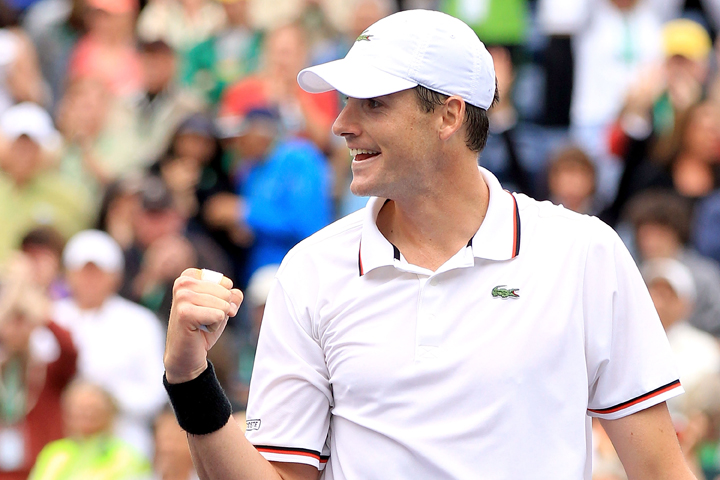When Jack Sock burst onto the professional tennis scene in 2011, he appeared destined for greatness. Already endowed with two grand slam titles, in the form of a U.S. Open Boys Championship and a Wimbledon Mixed Doubles Championship, the 6-foot-3-inch hard-serving teenager was slated as America’s premier talent—expected to follow, and perhaps eventually surpass, John Isner. In his first four years on tour, Sock has performed admirably in grand slams, reaching the third round of the U.S. Open in 2012 and 2013, and taking Nadal to four sets in their round of 16 matchup at Roland Garros this year. While the 26th-ranked Sock has awed opponents and spectators with his incredible topspin forehand (which averages 77 mph and 3,337 revolutions per minute), the second-best American still has not reached a grand slam quarterfinal.
When Donald Young entered the professional tennis world, he was only 15 years old. Despite his youth, he achieved the impossible in 2005: securing the Australian Open and the world’s top junior ranking at the age of 15. He showed considerable progress during his first few years as a professional, but after a decade, Young has only advanced as far as the fourth round in any grand slam tournament. Currently ranked 48th in the world, the 6-foot lefty experienced his best professional season in 2015, but it’s yet to be determined if his potential will ever translate into a major championship.
When John Isner decided to turn pro after four years at the University of Georgia, he was well past his teenage years. The 6-foot-ten-inch North Carolina native took the unbeaten path for his generation—attending college and developing his mental and physical capabilities before turning professional. Additionally, the hard-serving righty was not the product of America’s tennis academies, but rather developed his game in his hometown of Greensboro. While Isner has experienced the greatest amount of success of any current American player on tour, he’s a perennial third round player at the four major slams. What’s keeping Isner and his fellow Americans from challenging the dominance of Djokovic, Murray, and Federer?
It’s this precise question that has troubled the McEnroe brothers, the USTA community, and tennis fans around the country. It’s a question that has left Sock, Young, and Isner scratching their heads, and that has left Andy Roddick wondering if he’ll be the last American male to win a grand slam during the 21st century. In addressing this question, we also encounter an even bigger question: Is it time for the USTA to panic?
In response to the first question, I assert that our American players have struggled mightily as a result of a lack of comparable practice time relative to their European counterparts. However, I strongly disagree with the notion that it’s a period of crisis for U.S. men’s tennis. In support of this claim, I reference Malcolm Gladwell’s acclaimed book Outliers, and more specifically, his theory that success is largely predicated on one’s generational status.
In the twenty-first century, a greater proportion of American juniors are bypassing the college circuit and advancing straight to the professional stage. Despite the additional four years of professional tennis, America’s best male singles players lack the equivalent quantity of training received by international players. Secondary education is granted a higher premium in the United States, and when American players do have the chance to train, it’s on hard courts instead of on clay or grass surfaces. It’s also noteworthy that the United States continues to rely on academies for cultivating talent, as opposed to Europe’s strategy of placing its top talent in national and local centers around the continent. With several institutional fixes, the American men can once again rule the tennis world.
In his book Outliers, Malcolm Gladwell raises the following point: success is dependent on the extraordinary opportunities available in a given generation. Perhaps the next generation will experience profound changes in training centers, a reduction in income inequality (expanding the American talent pool), or better psychological coaching of young players. Gladwell’s theory of success reminds us that tennis is not a static profession, but susceptible to change based on greater societal factors. Thus, the next generation will have a talent pool shaped by society’s future beliefs on educational and psychological norms in tennis—let’s just hope future American coaching alleviates the pressure of performing well at grand slam competitions.
It’s easy to discard U.S. men’s tennis as a hopelessly dysfunctional machine that produces third-round contenders instead of grand slam champions. However, it must be remembered that tennis is a highly individualistic sport. Aside from the Davis Cup, it’s pretty unnatural to conceptualize success in terms of national achievement. I’m not worried about the ability of the U.S. tennis system to develop individual talent—Isner, Young, and Sock have achieved success on the ATP tour (albeit, to differing extents). What I am worried about is the slow response of American tennis to changes in training centers, income inequality, and coaching strategies. U.S. men’s singles will never reach its potential without a commitment to changing its archaic ways.





